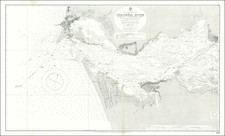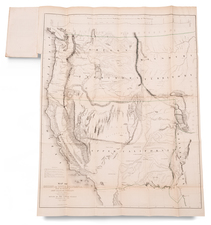The Best 19th-Century Map of Puget Sound. One Copy in OCLC.
Impressive and imposing 19th-century large-format map of Puget Sound, prepared by Deputy U.S. Surveyor Edgard M. Morgan in Olympia in 1875.
The map shows the whole of Puget Sound from Olympia and Tumwater at its base in the south to Whidbey Island ("Whidbey's Island") and the bottom tip of Fidalgo Island in the north.
The map has a clean 19th-century survey map aesthetic, with a township and range grid stretching over almost all of what the map covers. The few areas not integrated into the grid already have early landowners associated with them. The map also includes several reservations for the area’s native American peoples and United States Military Reservations (outlined in yellow).
The map is hand-colored by counties, beginning with the southern part of Whatcom in the north and encompassing all or part of Snohomish, Clallam, Jefferson, Islands, Kitsap, King, Mason, Pierce, and Thurston.
The Northern Pacific is shown stretching away from Tacoma, which had been selected as the western terminus only two years before the map was made. The only other railroad on the map is the "Seattle & W. R.R." which extends from Seattle proper to the south end of Lake Washington (quite the trek!)
One of the best features of the map is its complement of excellent inset bird's-eye and landscape views of communities around Puget Sound. Clockwise from the top these include: "Port Madison", "Port Gamble", "Tacoma Mill", "Port Discovery Mill", "City of Olympia", "Seattle", and "La Conner W.T."
Rarity
The map is very rare. OCLC locates a single holding (UC-Berkeley), and we are aware of others at the California State Library and the Museum of History & Industry (Seattle). One was offered in the Streeter sale, and John Howell offered an ex-library copy for $400 in 1972.
A native of Virginia and the seventh of 14 children, before arriving in Olympia, Washington Morgan bounced around the West for several years. There is record of him in San Miguel, New Mexico Territory, and in Idaho Falls, Idaho Territory, where, in 1864, he was a partner in incorporating the Oneida Road, Bridge and Ferry Co. in Idaho Falls before being bought out in 1865.
Morgan first appears in the Olympia-based Washington Standard on March 4, 1871, describing himself as a “civil engineer and surveyor” and offering “drawings and specifications prepared for building Bridges, and work superintended in any part of the Territory.” (p. 3) He met with at least some public approbation, as the July 29, 1871 issue mentions that “Mr. Morgan’s map of Port Townsend is spoken of by the papers as a triumph of topographical skill” (p. 2); and on October 14 the paper announced he had won “first diploma” at the Mutual Aid Fair for a “Map of Thurston County and Olympia and Harbor” (p. 1), the former compiled at the behest of the County Commissioners. (May 24, 1873, p. 3) It seems that a significant part of Morgan’s income came from contracts with the Territorial General Land Office in Olympia, the first of which he won in 1871 and the last in 1874. These entitled him to use the “Deputy Surveyor General” title that appears next to his name on this map.
Apparently, Edgar had trouble staying in one place. By some time in 1875, he was working as a civil engineer in San Francisco—which could explain the imprint of lithographers Britton & Rey that appears on his Puget Sound map. He won a contract to build water lines in Healdsburg in 1876 and that year also obtained a patent for a piece of hardware. After living in Santa Cruz for a few years, he returned to San Francisco, where he died of liver failure in 1880, leaving behind his wife and three children.











![[ Jefferson County - Olympic National Forest ] Quinalt Indian Reservation Township No. 24 North, Range No. 12 West, Willamette Meridian Washington](https://storage.googleapis.com/raremaps/img/small/101909.jpg)

![[Washington Territory]](https://storage.googleapis.com/raremaps/img/small/85513.jpg)


![[Collection of 10 manuscript charts and maps depicting the west coast of North America from Monterey, California, to just north of Salisbury Sound, Alaska.]](https://storage.googleapis.com/raremaps/img/small/98898.jpg)